Risk Management Report: ERP System Implementation in ABC Private Ltd
VerifiedAdded on 2022/08/27
|16
|3982
|17
Report
AI Summary
This report provides a detailed analysis of risk management in the context of Enterprise Resource Planning (ERP) system implementation within ABC organization, a retail company operating in Australia. The report highlights the importance of risk management in ensuring the successful implementation of ERP systems, which are crucial for managing and integrating various business processes. It reviews literature on risk management strategies, including risk identification, mitigation, and communication with stakeholders. The report also discusses the challenges faced by ABC organization during its ERP implementation, emphasizing the need for proper planning and risk mitigation to align business objectives with the system. The use of system maps and various risk management tools like fishbone diagrams and surveys are also discussed. Overall, the report underscores the significance of effective risk management in enhancing project success and improving business performance.
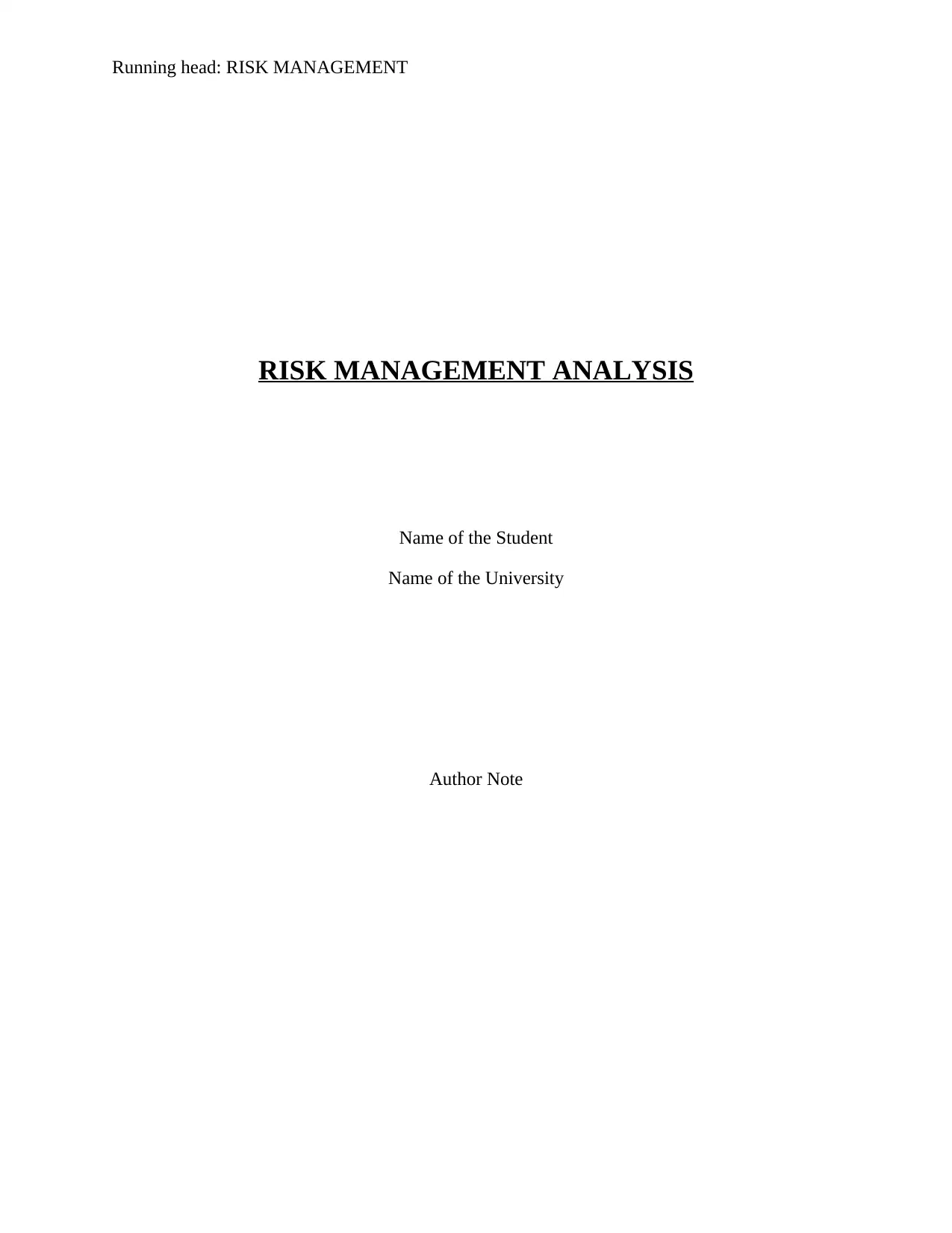
Running head: RISK MANAGEMENT
RISK MANAGEMENT ANALYSIS
Name of the Student
Name of the University
Author Note
RISK MANAGEMENT ANALYSIS
Name of the Student
Name of the University
Author Note
Paraphrase This Document
Need a fresh take? Get an instant paraphrase of this document with our AI Paraphraser
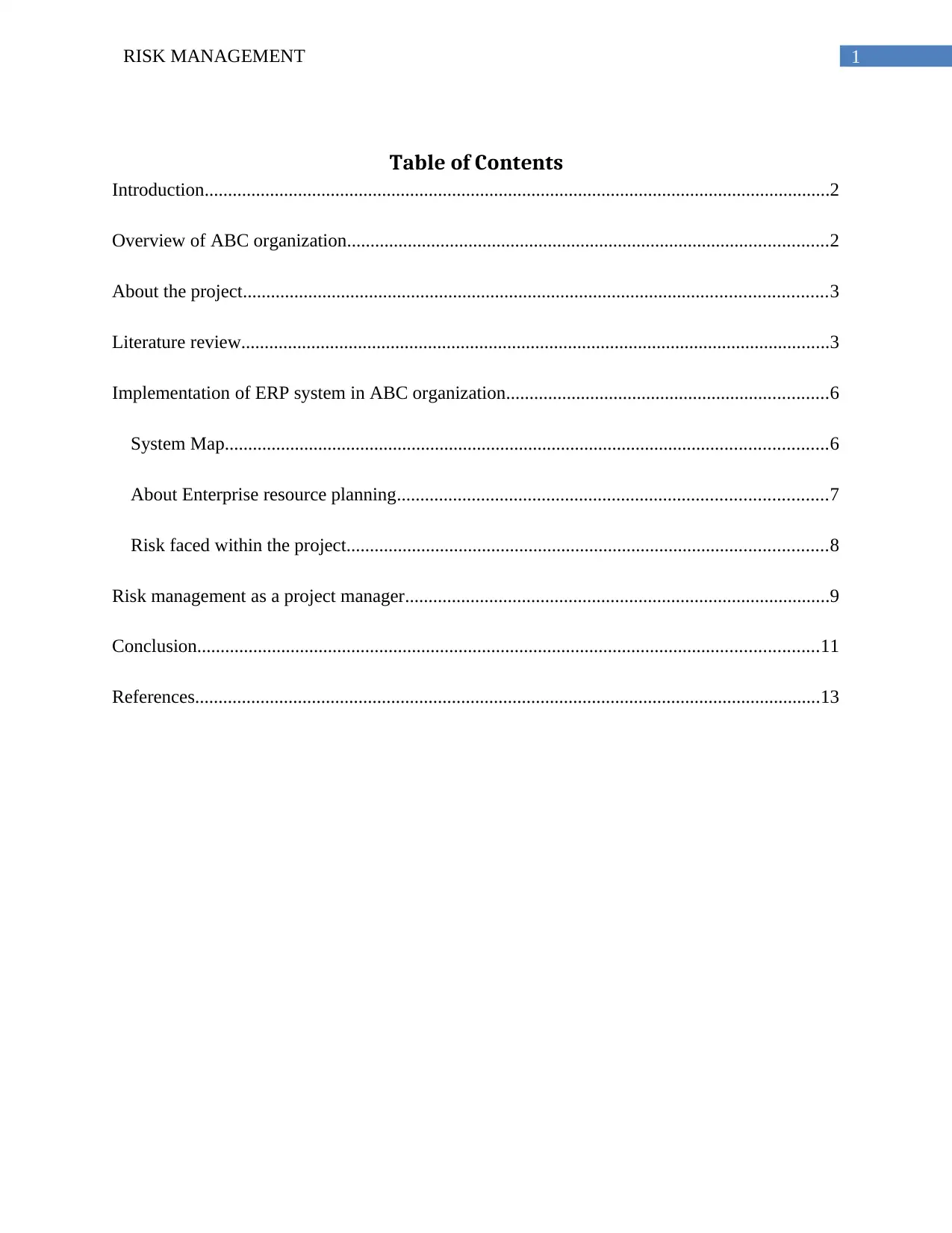
1RISK MANAGEMENT
Table of Contents
Introduction......................................................................................................................................2
Overview of ABC organization.......................................................................................................2
About the project.............................................................................................................................3
Literature review..............................................................................................................................3
Implementation of ERP system in ABC organization.....................................................................6
System Map.................................................................................................................................6
About Enterprise resource planning............................................................................................7
Risk faced within the project.......................................................................................................8
Risk management as a project manager...........................................................................................9
Conclusion.....................................................................................................................................11
References......................................................................................................................................13
Table of Contents
Introduction......................................................................................................................................2
Overview of ABC organization.......................................................................................................2
About the project.............................................................................................................................3
Literature review..............................................................................................................................3
Implementation of ERP system in ABC organization.....................................................................6
System Map.................................................................................................................................6
About Enterprise resource planning............................................................................................7
Risk faced within the project.......................................................................................................8
Risk management as a project manager...........................................................................................9
Conclusion.....................................................................................................................................11
References......................................................................................................................................13
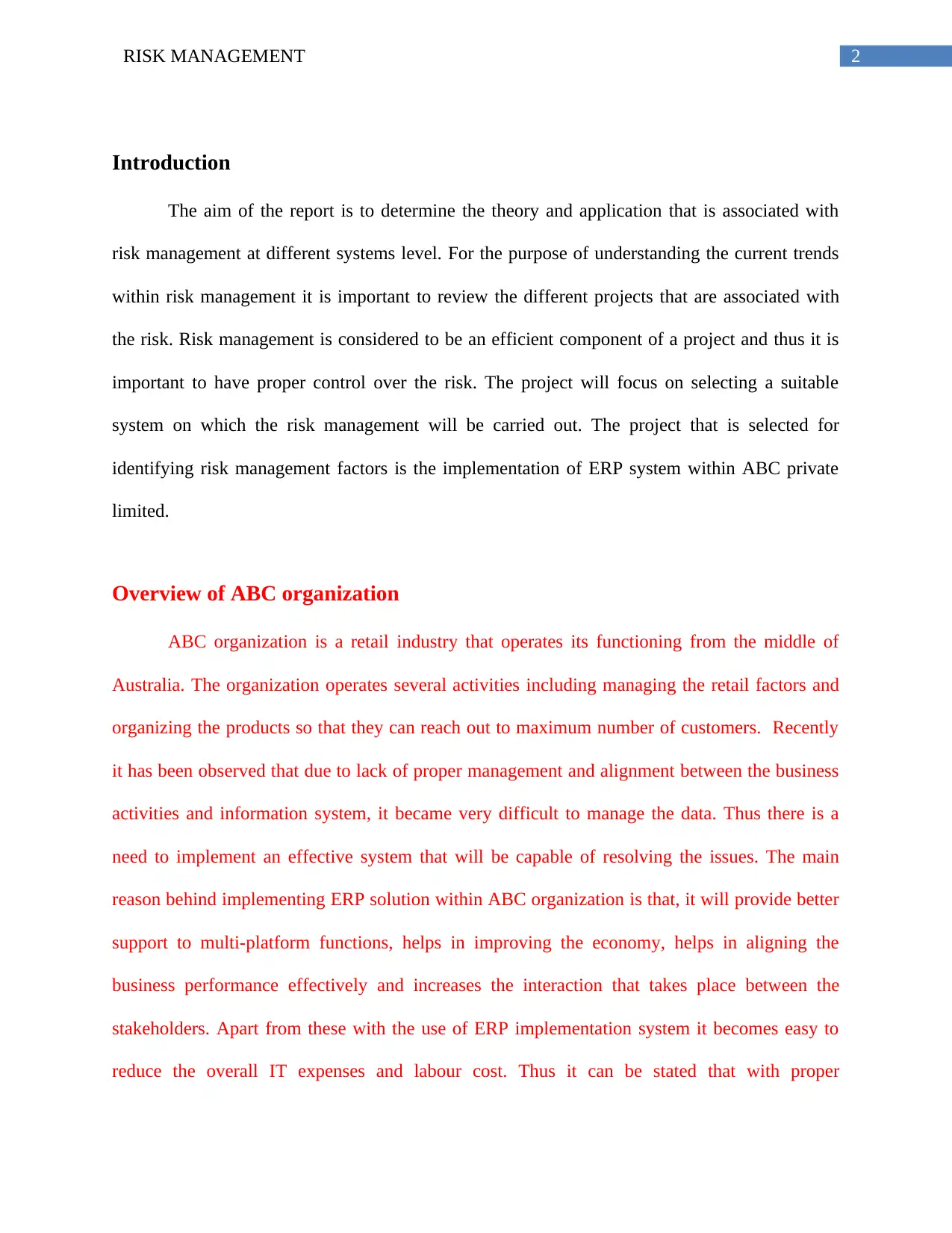
2RISK MANAGEMENT
Introduction
The aim of the report is to determine the theory and application that is associated with
risk management at different systems level. For the purpose of understanding the current trends
within risk management it is important to review the different projects that are associated with
the risk. Risk management is considered to be an efficient component of a project and thus it is
important to have proper control over the risk. The project will focus on selecting a suitable
system on which the risk management will be carried out. The project that is selected for
identifying risk management factors is the implementation of ERP system within ABC private
limited.
Overview of ABC organization
ABC organization is a retail industry that operates its functioning from the middle of
Australia. The organization operates several activities including managing the retail factors and
organizing the products so that they can reach out to maximum number of customers. Recently
it has been observed that due to lack of proper management and alignment between the business
activities and information system, it became very difficult to manage the data. Thus there is a
need to implement an effective system that will be capable of resolving the issues. The main
reason behind implementing ERP solution within ABC organization is that, it will provide better
support to multi-platform functions, helps in improving the economy, helps in aligning the
business performance effectively and increases the interaction that takes place between the
stakeholders. Apart from these with the use of ERP implementation system it becomes easy to
reduce the overall IT expenses and labour cost. Thus it can be stated that with proper
Introduction
The aim of the report is to determine the theory and application that is associated with
risk management at different systems level. For the purpose of understanding the current trends
within risk management it is important to review the different projects that are associated with
the risk. Risk management is considered to be an efficient component of a project and thus it is
important to have proper control over the risk. The project will focus on selecting a suitable
system on which the risk management will be carried out. The project that is selected for
identifying risk management factors is the implementation of ERP system within ABC private
limited.
Overview of ABC organization
ABC organization is a retail industry that operates its functioning from the middle of
Australia. The organization operates several activities including managing the retail factors and
organizing the products so that they can reach out to maximum number of customers. Recently
it has been observed that due to lack of proper management and alignment between the business
activities and information system, it became very difficult to manage the data. Thus there is a
need to implement an effective system that will be capable of resolving the issues. The main
reason behind implementing ERP solution within ABC organization is that, it will provide better
support to multi-platform functions, helps in improving the economy, helps in aligning the
business performance effectively and increases the interaction that takes place between the
stakeholders. Apart from these with the use of ERP implementation system it becomes easy to
reduce the overall IT expenses and labour cost. Thus it can be stated that with proper
⊘ This is a preview!⊘
Do you want full access?
Subscribe today to unlock all pages.

Trusted by 1+ million students worldwide
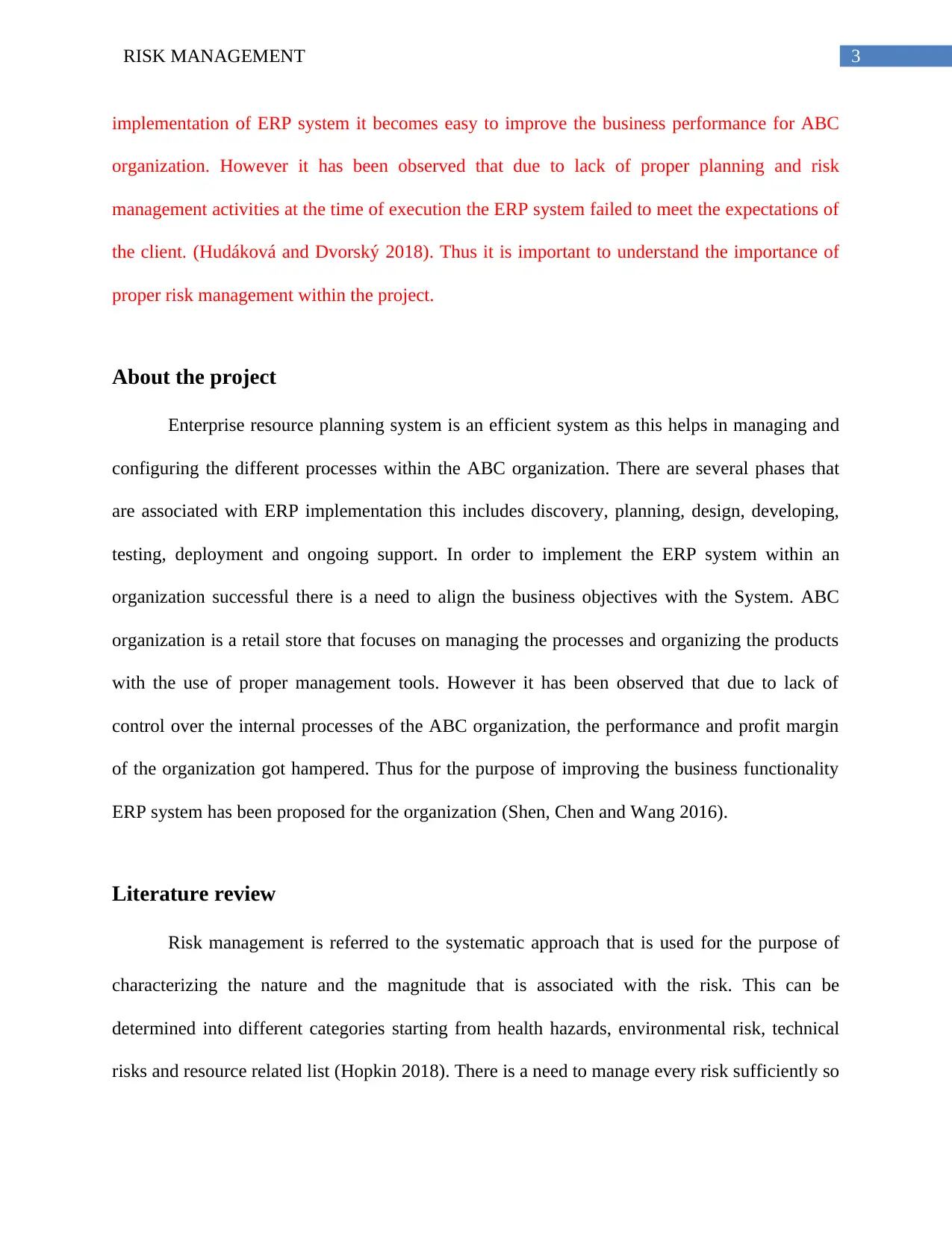
3RISK MANAGEMENT
implementation of ERP system it becomes easy to improve the business performance for ABC
organization. However it has been observed that due to lack of proper planning and risk
management activities at the time of execution the ERP system failed to meet the expectations of
the client. (Hudáková and Dvorský 2018). Thus it is important to understand the importance of
proper risk management within the project.
About the project
Enterprise resource planning system is an efficient system as this helps in managing and
configuring the different processes within the ABC organization. There are several phases that
are associated with ERP implementation this includes discovery, planning, design, developing,
testing, deployment and ongoing support. In order to implement the ERP system within an
organization successful there is a need to align the business objectives with the System. ABC
organization is a retail store that focuses on managing the processes and organizing the products
with the use of proper management tools. However it has been observed that due to lack of
control over the internal processes of the ABC organization, the performance and profit margin
of the organization got hampered. Thus for the purpose of improving the business functionality
ERP system has been proposed for the organization (Shen, Chen and Wang 2016).
Literature review
Risk management is referred to the systematic approach that is used for the purpose of
characterizing the nature and the magnitude that is associated with the risk. This can be
determined into different categories starting from health hazards, environmental risk, technical
risks and resource related list (Hopkin 2018). There is a need to manage every risk sufficiently so
implementation of ERP system it becomes easy to improve the business performance for ABC
organization. However it has been observed that due to lack of proper planning and risk
management activities at the time of execution the ERP system failed to meet the expectations of
the client. (Hudáková and Dvorský 2018). Thus it is important to understand the importance of
proper risk management within the project.
About the project
Enterprise resource planning system is an efficient system as this helps in managing and
configuring the different processes within the ABC organization. There are several phases that
are associated with ERP implementation this includes discovery, planning, design, developing,
testing, deployment and ongoing support. In order to implement the ERP system within an
organization successful there is a need to align the business objectives with the System. ABC
organization is a retail store that focuses on managing the processes and organizing the products
with the use of proper management tools. However it has been observed that due to lack of
control over the internal processes of the ABC organization, the performance and profit margin
of the organization got hampered. Thus for the purpose of improving the business functionality
ERP system has been proposed for the organization (Shen, Chen and Wang 2016).
Literature review
Risk management is referred to the systematic approach that is used for the purpose of
characterizing the nature and the magnitude that is associated with the risk. This can be
determined into different categories starting from health hazards, environmental risk, technical
risks and resource related list (Hopkin 2018). There is a need to manage every risk sufficiently so
Paraphrase This Document
Need a fresh take? Get an instant paraphrase of this document with our AI Paraphraser
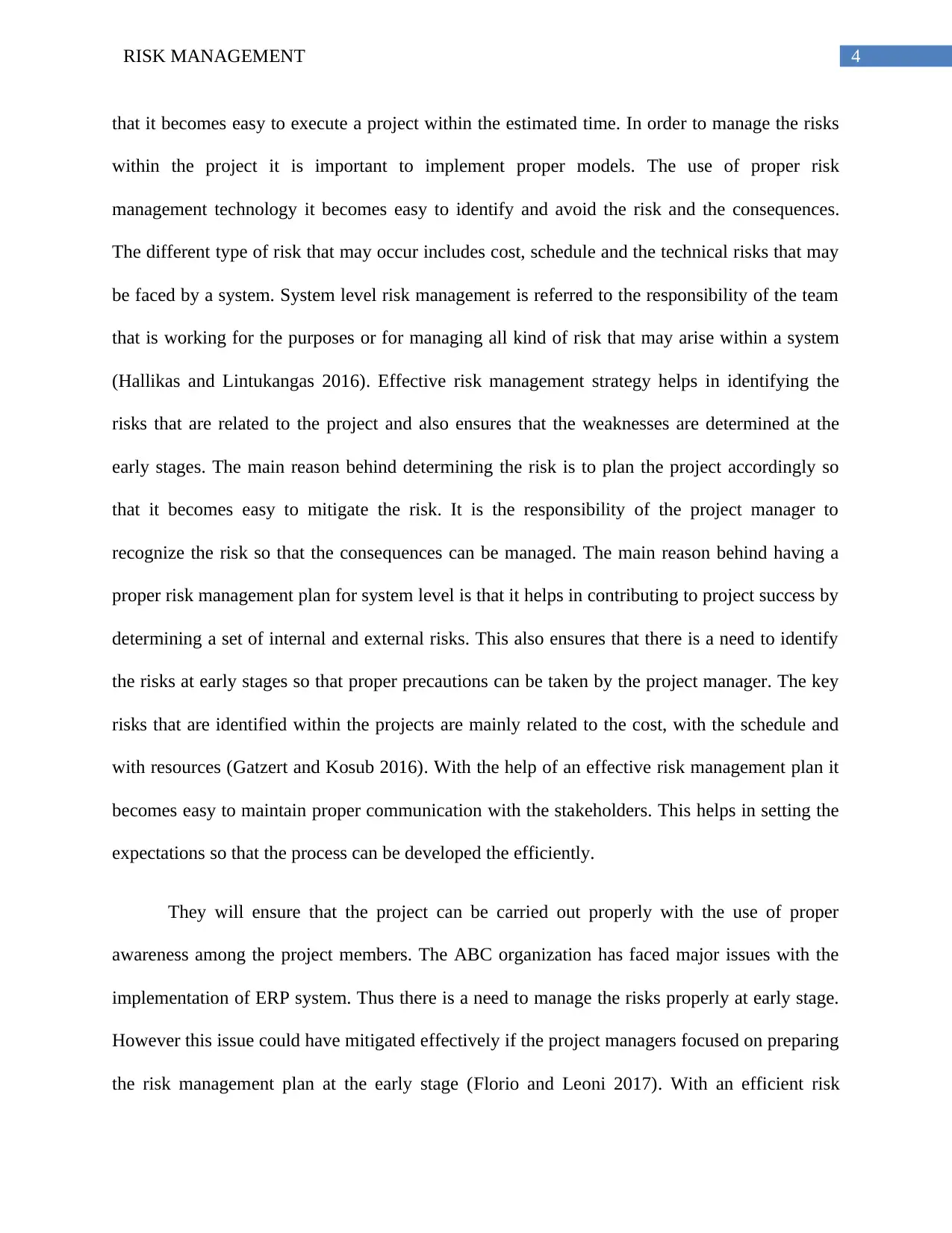
4RISK MANAGEMENT
that it becomes easy to execute a project within the estimated time. In order to manage the risks
within the project it is important to implement proper models. The use of proper risk
management technology it becomes easy to identify and avoid the risk and the consequences.
The different type of risk that may occur includes cost, schedule and the technical risks that may
be faced by a system. System level risk management is referred to the responsibility of the team
that is working for the purposes or for managing all kind of risk that may arise within a system
(Hallikas and Lintukangas 2016). Effective risk management strategy helps in identifying the
risks that are related to the project and also ensures that the weaknesses are determined at the
early stages. The main reason behind determining the risk is to plan the project accordingly so
that it becomes easy to mitigate the risk. It is the responsibility of the project manager to
recognize the risk so that the consequences can be managed. The main reason behind having a
proper risk management plan for system level is that it helps in contributing to project success by
determining a set of internal and external risks. This also ensures that there is a need to identify
the risks at early stages so that proper precautions can be taken by the project manager. The key
risks that are identified within the projects are mainly related to the cost, with the schedule and
with resources (Gatzert and Kosub 2016). With the help of an effective risk management plan it
becomes easy to maintain proper communication with the stakeholders. This helps in setting the
expectations so that the process can be developed the efficiently.
They will ensure that the project can be carried out properly with the use of proper
awareness among the project members. The ABC organization has faced major issues with the
implementation of ERP system. Thus there is a need to manage the risks properly at early stage.
However this issue could have mitigated effectively if the project managers focused on preparing
the risk management plan at the early stage (Florio and Leoni 2017). With an efficient risk
that it becomes easy to execute a project within the estimated time. In order to manage the risks
within the project it is important to implement proper models. The use of proper risk
management technology it becomes easy to identify and avoid the risk and the consequences.
The different type of risk that may occur includes cost, schedule and the technical risks that may
be faced by a system. System level risk management is referred to the responsibility of the team
that is working for the purposes or for managing all kind of risk that may arise within a system
(Hallikas and Lintukangas 2016). Effective risk management strategy helps in identifying the
risks that are related to the project and also ensures that the weaknesses are determined at the
early stages. The main reason behind determining the risk is to plan the project accordingly so
that it becomes easy to mitigate the risk. It is the responsibility of the project manager to
recognize the risk so that the consequences can be managed. The main reason behind having a
proper risk management plan for system level is that it helps in contributing to project success by
determining a set of internal and external risks. This also ensures that there is a need to identify
the risks at early stages so that proper precautions can be taken by the project manager. The key
risks that are identified within the projects are mainly related to the cost, with the schedule and
with resources (Gatzert and Kosub 2016). With the help of an effective risk management plan it
becomes easy to maintain proper communication with the stakeholders. This helps in setting the
expectations so that the process can be developed the efficiently.
They will ensure that the project can be carried out properly with the use of proper
awareness among the project members. The ABC organization has faced major issues with the
implementation of ERP system. Thus there is a need to manage the risks properly at early stage.
However this issue could have mitigated effectively if the project managers focused on preparing
the risk management plan at the early stage (Florio and Leoni 2017). With an efficient risk
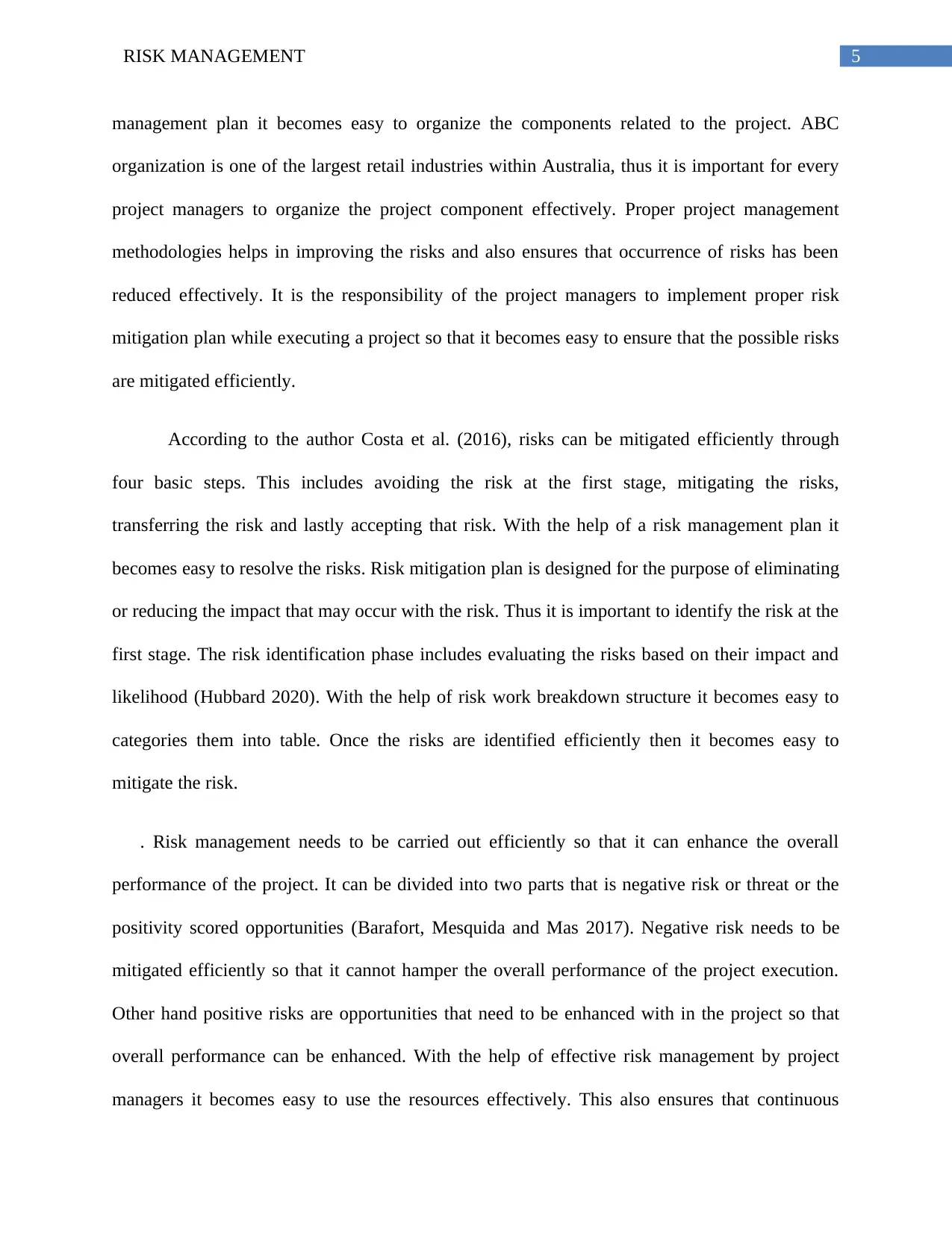
5RISK MANAGEMENT
management plan it becomes easy to organize the components related to the project. ABC
organization is one of the largest retail industries within Australia, thus it is important for every
project managers to organize the project component effectively. Proper project management
methodologies helps in improving the risks and also ensures that occurrence of risks has been
reduced effectively. It is the responsibility of the project managers to implement proper risk
mitigation plan while executing a project so that it becomes easy to ensure that the possible risks
are mitigated efficiently.
According to the author Costa et al. (2016), risks can be mitigated efficiently through
four basic steps. This includes avoiding the risk at the first stage, mitigating the risks,
transferring the risk and lastly accepting that risk. With the help of a risk management plan it
becomes easy to resolve the risks. Risk mitigation plan is designed for the purpose of eliminating
or reducing the impact that may occur with the risk. Thus it is important to identify the risk at the
first stage. The risk identification phase includes evaluating the risks based on their impact and
likelihood (Hubbard 2020). With the help of risk work breakdown structure it becomes easy to
categories them into table. Once the risks are identified efficiently then it becomes easy to
mitigate the risk.
. Risk management needs to be carried out efficiently so that it can enhance the overall
performance of the project. It can be divided into two parts that is negative risk or threat or the
positivity scored opportunities (Barafort, Mesquida and Mas 2017). Negative risk needs to be
mitigated efficiently so that it cannot hamper the overall performance of the project execution.
Other hand positive risks are opportunities that need to be enhanced with in the project so that
overall performance can be enhanced. With the help of effective risk management by project
managers it becomes easy to use the resources effectively. This also ensures that continuous
management plan it becomes easy to organize the components related to the project. ABC
organization is one of the largest retail industries within Australia, thus it is important for every
project managers to organize the project component effectively. Proper project management
methodologies helps in improving the risks and also ensures that occurrence of risks has been
reduced effectively. It is the responsibility of the project managers to implement proper risk
mitigation plan while executing a project so that it becomes easy to ensure that the possible risks
are mitigated efficiently.
According to the author Costa et al. (2016), risks can be mitigated efficiently through
four basic steps. This includes avoiding the risk at the first stage, mitigating the risks,
transferring the risk and lastly accepting that risk. With the help of a risk management plan it
becomes easy to resolve the risks. Risk mitigation plan is designed for the purpose of eliminating
or reducing the impact that may occur with the risk. Thus it is important to identify the risk at the
first stage. The risk identification phase includes evaluating the risks based on their impact and
likelihood (Hubbard 2020). With the help of risk work breakdown structure it becomes easy to
categories them into table. Once the risks are identified efficiently then it becomes easy to
mitigate the risk.
. Risk management needs to be carried out efficiently so that it can enhance the overall
performance of the project. It can be divided into two parts that is negative risk or threat or the
positivity scored opportunities (Barafort, Mesquida and Mas 2017). Negative risk needs to be
mitigated efficiently so that it cannot hamper the overall performance of the project execution.
Other hand positive risks are opportunities that need to be enhanced with in the project so that
overall performance can be enhanced. With the help of effective risk management by project
managers it becomes easy to use the resources effectively. This also ensures that continuous
⊘ This is a preview!⊘
Do you want full access?
Subscribe today to unlock all pages.

Trusted by 1+ million students worldwide
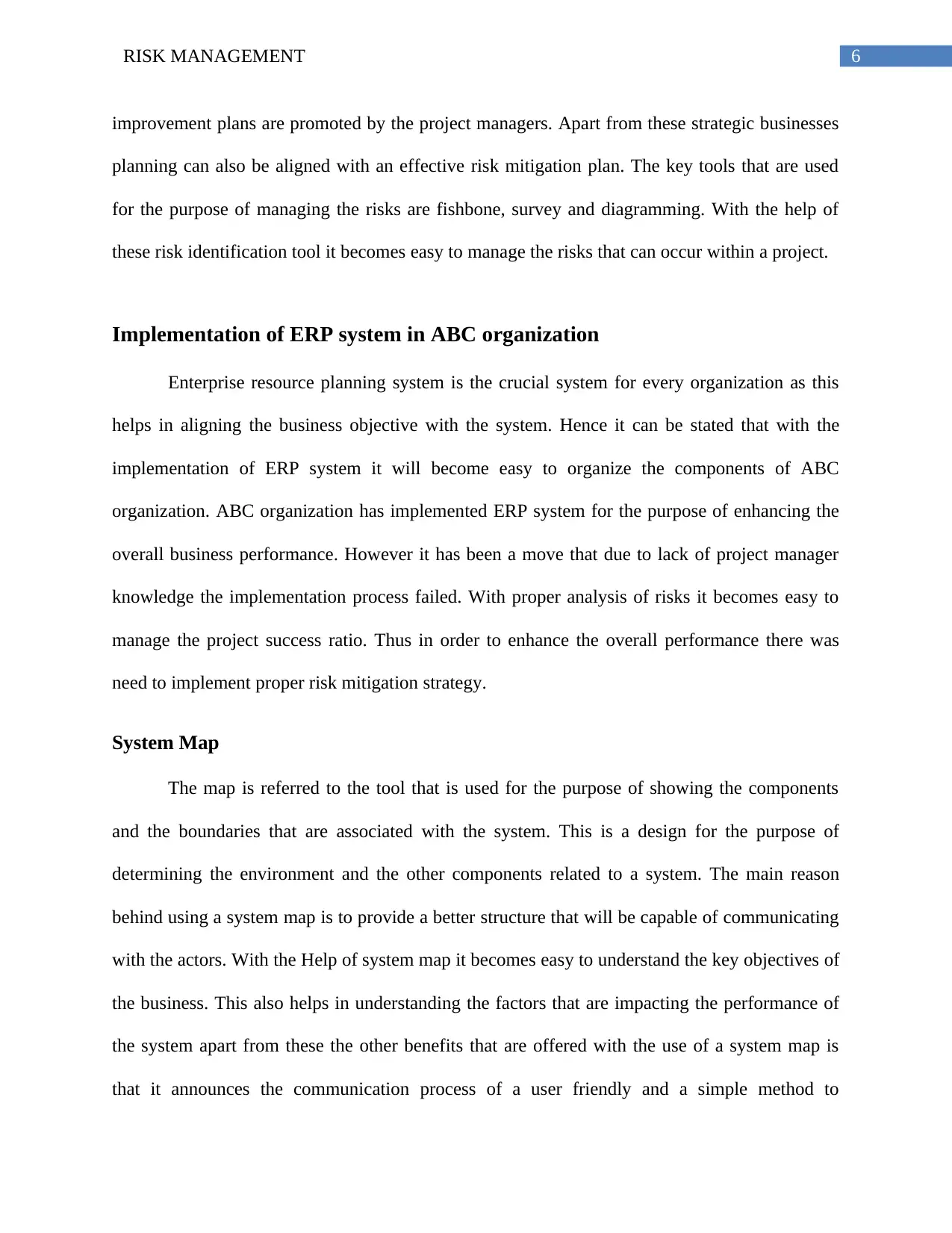
6RISK MANAGEMENT
improvement plans are promoted by the project managers. Apart from these strategic businesses
planning can also be aligned with an effective risk mitigation plan. The key tools that are used
for the purpose of managing the risks are fishbone, survey and diagramming. With the help of
these risk identification tool it becomes easy to manage the risks that can occur within a project.
Implementation of ERP system in ABC organization
Enterprise resource planning system is the crucial system for every organization as this
helps in aligning the business objective with the system. Hence it can be stated that with the
implementation of ERP system it will become easy to organize the components of ABC
organization. ABC organization has implemented ERP system for the purpose of enhancing the
overall business performance. However it has been a move that due to lack of project manager
knowledge the implementation process failed. With proper analysis of risks it becomes easy to
manage the project success ratio. Thus in order to enhance the overall performance there was
need to implement proper risk mitigation strategy.
System Map
The map is referred to the tool that is used for the purpose of showing the components
and the boundaries that are associated with the system. This is a design for the purpose of
determining the environment and the other components related to a system. The main reason
behind using a system map is to provide a better structure that will be capable of communicating
with the actors. With the Help of system map it becomes easy to understand the key objectives of
the business. This also helps in understanding the factors that are impacting the performance of
the system apart from these the other benefits that are offered with the use of a system map is
that it announces the communication process of a user friendly and a simple method to
improvement plans are promoted by the project managers. Apart from these strategic businesses
planning can also be aligned with an effective risk mitigation plan. The key tools that are used
for the purpose of managing the risks are fishbone, survey and diagramming. With the help of
these risk identification tool it becomes easy to manage the risks that can occur within a project.
Implementation of ERP system in ABC organization
Enterprise resource planning system is the crucial system for every organization as this
helps in aligning the business objective with the system. Hence it can be stated that with the
implementation of ERP system it will become easy to organize the components of ABC
organization. ABC organization has implemented ERP system for the purpose of enhancing the
overall business performance. However it has been a move that due to lack of project manager
knowledge the implementation process failed. With proper analysis of risks it becomes easy to
manage the project success ratio. Thus in order to enhance the overall performance there was
need to implement proper risk mitigation strategy.
System Map
The map is referred to the tool that is used for the purpose of showing the components
and the boundaries that are associated with the system. This is a design for the purpose of
determining the environment and the other components related to a system. The main reason
behind using a system map is to provide a better structure that will be capable of communicating
with the actors. With the Help of system map it becomes easy to understand the key objectives of
the business. This also helps in understanding the factors that are impacting the performance of
the system apart from these the other benefits that are offered with the use of a system map is
that it announces the communication process of a user friendly and a simple method to
Paraphrase This Document
Need a fresh take? Get an instant paraphrase of this document with our AI Paraphraser
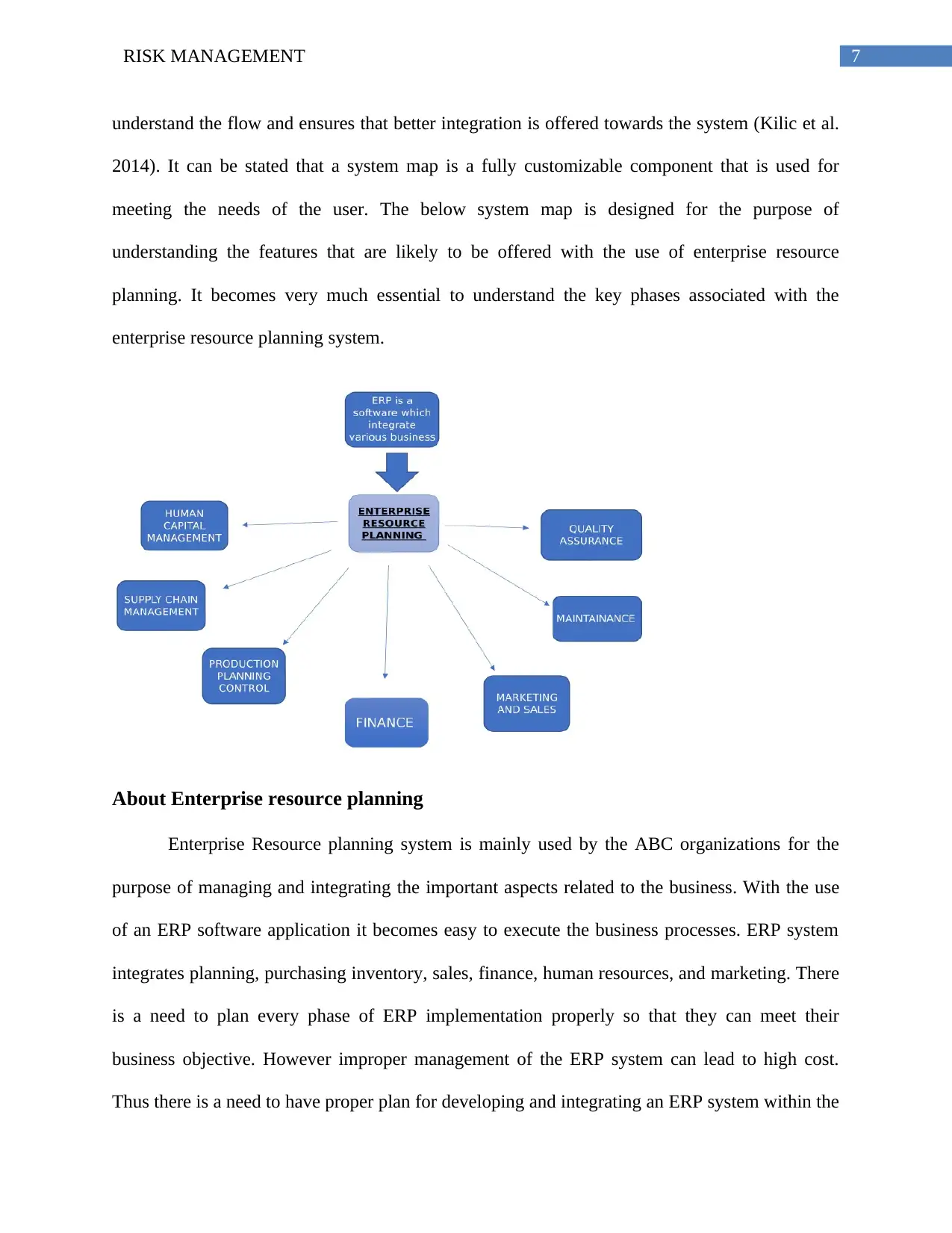
7RISK MANAGEMENT
understand the flow and ensures that better integration is offered towards the system (Kilic et al.
2014). It can be stated that a system map is a fully customizable component that is used for
meeting the needs of the user. The below system map is designed for the purpose of
understanding the features that are likely to be offered with the use of enterprise resource
planning. It becomes very much essential to understand the key phases associated with the
enterprise resource planning system.
About Enterprise resource planning
Enterprise Resource planning system is mainly used by the ABC organizations for the
purpose of managing and integrating the important aspects related to the business. With the use
of an ERP software application it becomes easy to execute the business processes. ERP system
integrates planning, purchasing inventory, sales, finance, human resources, and marketing. There
is a need to plan every phase of ERP implementation properly so that they can meet their
business objective. However improper management of the ERP system can lead to high cost.
Thus there is a need to have proper plan for developing and integrating an ERP system within the
understand the flow and ensures that better integration is offered towards the system (Kilic et al.
2014). It can be stated that a system map is a fully customizable component that is used for
meeting the needs of the user. The below system map is designed for the purpose of
understanding the features that are likely to be offered with the use of enterprise resource
planning. It becomes very much essential to understand the key phases associated with the
enterprise resource planning system.
About Enterprise resource planning
Enterprise Resource planning system is mainly used by the ABC organizations for the
purpose of managing and integrating the important aspects related to the business. With the use
of an ERP software application it becomes easy to execute the business processes. ERP system
integrates planning, purchasing inventory, sales, finance, human resources, and marketing. There
is a need to plan every phase of ERP implementation properly so that they can meet their
business objective. However improper management of the ERP system can lead to high cost.
Thus there is a need to have proper plan for developing and integrating an ERP system within the
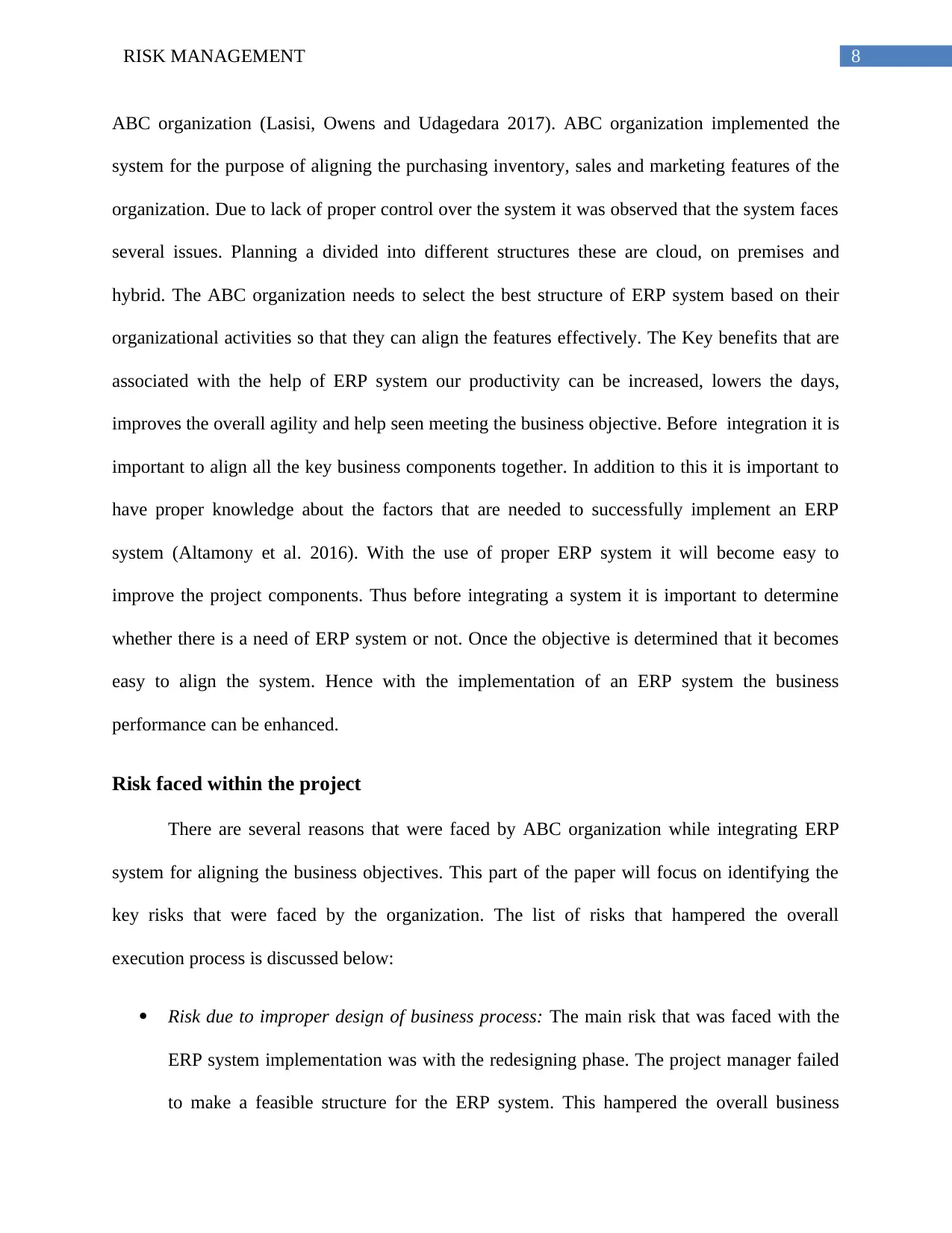
8RISK MANAGEMENT
ABC organization (Lasisi, Owens and Udagedara 2017). ABC organization implemented the
system for the purpose of aligning the purchasing inventory, sales and marketing features of the
organization. Due to lack of proper control over the system it was observed that the system faces
several issues. Planning a divided into different structures these are cloud, on premises and
hybrid. The ABC organization needs to select the best structure of ERP system based on their
organizational activities so that they can align the features effectively. The Key benefits that are
associated with the help of ERP system our productivity can be increased, lowers the days,
improves the overall agility and help seen meeting the business objective. Before integration it is
important to align all the key business components together. In addition to this it is important to
have proper knowledge about the factors that are needed to successfully implement an ERP
system (Altamony et al. 2016). With the use of proper ERP system it will become easy to
improve the project components. Thus before integrating a system it is important to determine
whether there is a need of ERP system or not. Once the objective is determined that it becomes
easy to align the system. Hence with the implementation of an ERP system the business
performance can be enhanced.
Risk faced within the project
There are several reasons that were faced by ABC organization while integrating ERP
system for aligning the business objectives. This part of the paper will focus on identifying the
key risks that were faced by the organization. The list of risks that hampered the overall
execution process is discussed below:
Risk due to improper design of business process: The main risk that was faced with the
ERP system implementation was with the redesigning phase. The project manager failed
to make a feasible structure for the ERP system. This hampered the overall business
ABC organization (Lasisi, Owens and Udagedara 2017). ABC organization implemented the
system for the purpose of aligning the purchasing inventory, sales and marketing features of the
organization. Due to lack of proper control over the system it was observed that the system faces
several issues. Planning a divided into different structures these are cloud, on premises and
hybrid. The ABC organization needs to select the best structure of ERP system based on their
organizational activities so that they can align the features effectively. The Key benefits that are
associated with the help of ERP system our productivity can be increased, lowers the days,
improves the overall agility and help seen meeting the business objective. Before integration it is
important to align all the key business components together. In addition to this it is important to
have proper knowledge about the factors that are needed to successfully implement an ERP
system (Altamony et al. 2016). With the use of proper ERP system it will become easy to
improve the project components. Thus before integrating a system it is important to determine
whether there is a need of ERP system or not. Once the objective is determined that it becomes
easy to align the system. Hence with the implementation of an ERP system the business
performance can be enhanced.
Risk faced within the project
There are several reasons that were faced by ABC organization while integrating ERP
system for aligning the business objectives. This part of the paper will focus on identifying the
key risks that were faced by the organization. The list of risks that hampered the overall
execution process is discussed below:
Risk due to improper design of business process: The main risk that was faced with the
ERP system implementation was with the redesigning phase. The project manager failed
to make a feasible structure for the ERP system. This hampered the overall business
⊘ This is a preview!⊘
Do you want full access?
Subscribe today to unlock all pages.

Trusted by 1+ million students worldwide
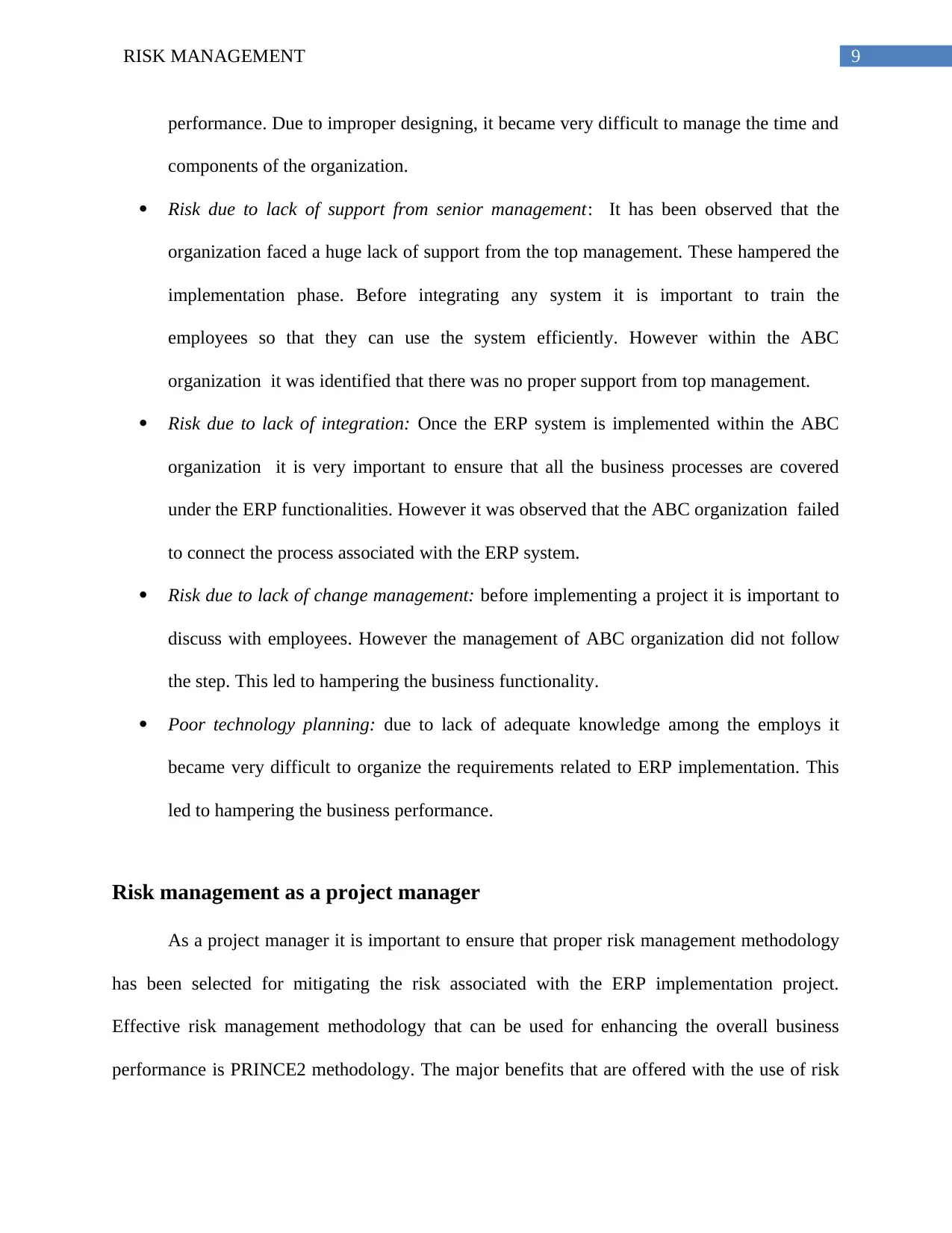
9RISK MANAGEMENT
performance. Due to improper designing, it became very difficult to manage the time and
components of the organization.
Risk due to lack of support from senior management: It has been observed that the
organization faced a huge lack of support from the top management. These hampered the
implementation phase. Before integrating any system it is important to train the
employees so that they can use the system efficiently. However within the ABC
organization it was identified that there was no proper support from top management.
Risk due to lack of integration: Once the ERP system is implemented within the ABC
organization it is very important to ensure that all the business processes are covered
under the ERP functionalities. However it was observed that the ABC organization failed
to connect the process associated with the ERP system.
Risk due to lack of change management: before implementing a project it is important to
discuss with employees. However the management of ABC organization did not follow
the step. This led to hampering the business functionality.
Poor technology planning: due to lack of adequate knowledge among the employs it
became very difficult to organize the requirements related to ERP implementation. This
led to hampering the business performance.
Risk management as a project manager
As a project manager it is important to ensure that proper risk management methodology
has been selected for mitigating the risk associated with the ERP implementation project.
Effective risk management methodology that can be used for enhancing the overall business
performance is PRINCE2 methodology. The major benefits that are offered with the use of risk
performance. Due to improper designing, it became very difficult to manage the time and
components of the organization.
Risk due to lack of support from senior management: It has been observed that the
organization faced a huge lack of support from the top management. These hampered the
implementation phase. Before integrating any system it is important to train the
employees so that they can use the system efficiently. However within the ABC
organization it was identified that there was no proper support from top management.
Risk due to lack of integration: Once the ERP system is implemented within the ABC
organization it is very important to ensure that all the business processes are covered
under the ERP functionalities. However it was observed that the ABC organization failed
to connect the process associated with the ERP system.
Risk due to lack of change management: before implementing a project it is important to
discuss with employees. However the management of ABC organization did not follow
the step. This led to hampering the business functionality.
Poor technology planning: due to lack of adequate knowledge among the employs it
became very difficult to organize the requirements related to ERP implementation. This
led to hampering the business performance.
Risk management as a project manager
As a project manager it is important to ensure that proper risk management methodology
has been selected for mitigating the risk associated with the ERP implementation project.
Effective risk management methodology that can be used for enhancing the overall business
performance is PRINCE2 methodology. The major benefits that are offered with the use of risk
Paraphrase This Document
Need a fresh take? Get an instant paraphrase of this document with our AI Paraphraser
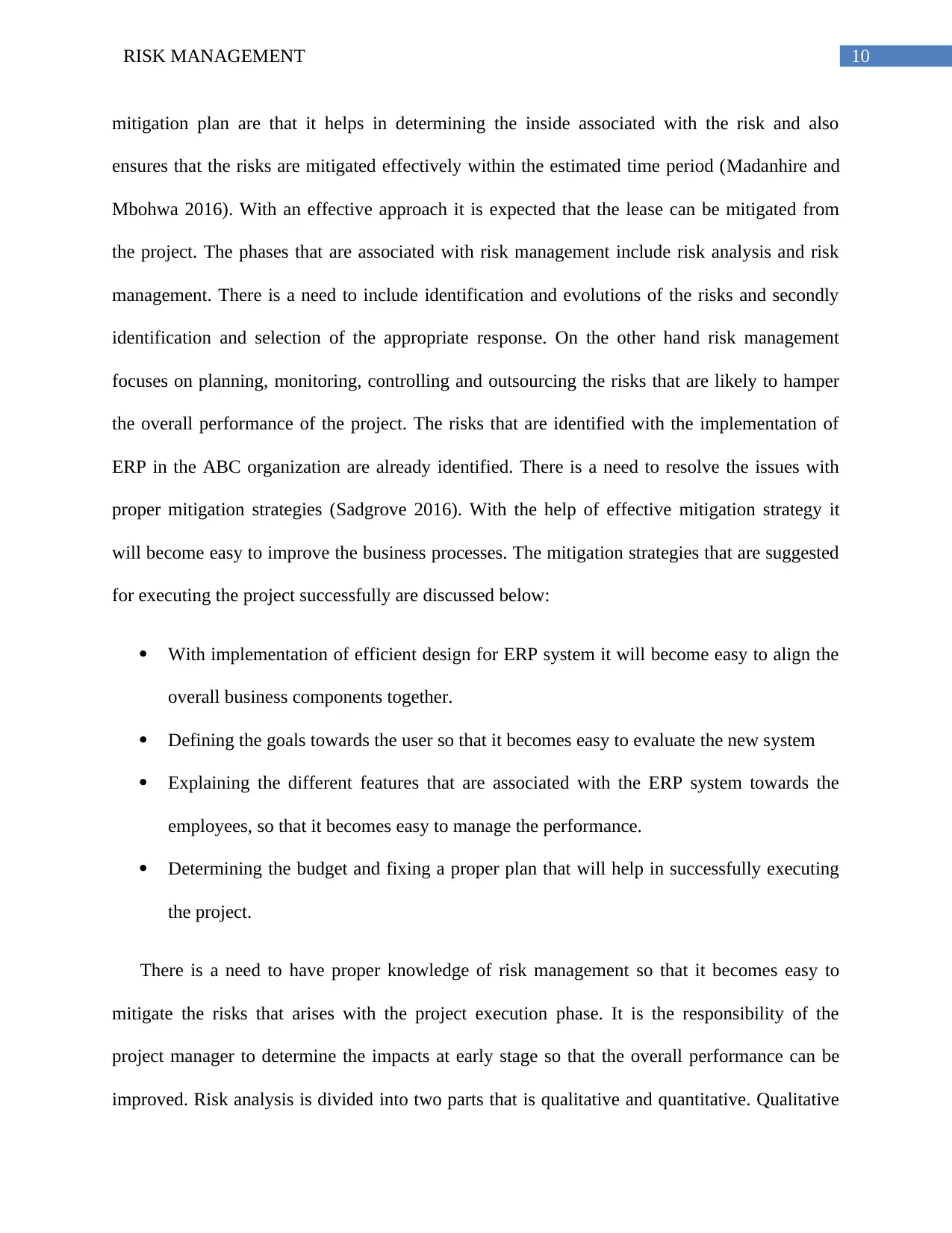
10RISK MANAGEMENT
mitigation plan are that it helps in determining the inside associated with the risk and also
ensures that the risks are mitigated effectively within the estimated time period (Madanhire and
Mbohwa 2016). With an effective approach it is expected that the lease can be mitigated from
the project. The phases that are associated with risk management include risk analysis and risk
management. There is a need to include identification and evolutions of the risks and secondly
identification and selection of the appropriate response. On the other hand risk management
focuses on planning, monitoring, controlling and outsourcing the risks that are likely to hamper
the overall performance of the project. The risks that are identified with the implementation of
ERP in the ABC organization are already identified. There is a need to resolve the issues with
proper mitigation strategies (Sadgrove 2016). With the help of effective mitigation strategy it
will become easy to improve the business processes. The mitigation strategies that are suggested
for executing the project successfully are discussed below:
With implementation of efficient design for ERP system it will become easy to align the
overall business components together.
Defining the goals towards the user so that it becomes easy to evaluate the new system
Explaining the different features that are associated with the ERP system towards the
employees, so that it becomes easy to manage the performance.
Determining the budget and fixing a proper plan that will help in successfully executing
the project.
There is a need to have proper knowledge of risk management so that it becomes easy to
mitigate the risks that arises with the project execution phase. It is the responsibility of the
project manager to determine the impacts at early stage so that the overall performance can be
improved. Risk analysis is divided into two parts that is qualitative and quantitative. Qualitative
mitigation plan are that it helps in determining the inside associated with the risk and also
ensures that the risks are mitigated effectively within the estimated time period (Madanhire and
Mbohwa 2016). With an effective approach it is expected that the lease can be mitigated from
the project. The phases that are associated with risk management include risk analysis and risk
management. There is a need to include identification and evolutions of the risks and secondly
identification and selection of the appropriate response. On the other hand risk management
focuses on planning, monitoring, controlling and outsourcing the risks that are likely to hamper
the overall performance of the project. The risks that are identified with the implementation of
ERP in the ABC organization are already identified. There is a need to resolve the issues with
proper mitigation strategies (Sadgrove 2016). With the help of effective mitigation strategy it
will become easy to improve the business processes. The mitigation strategies that are suggested
for executing the project successfully are discussed below:
With implementation of efficient design for ERP system it will become easy to align the
overall business components together.
Defining the goals towards the user so that it becomes easy to evaluate the new system
Explaining the different features that are associated with the ERP system towards the
employees, so that it becomes easy to manage the performance.
Determining the budget and fixing a proper plan that will help in successfully executing
the project.
There is a need to have proper knowledge of risk management so that it becomes easy to
mitigate the risks that arises with the project execution phase. It is the responsibility of the
project manager to determine the impacts at early stage so that the overall performance can be
improved. Risk analysis is divided into two parts that is qualitative and quantitative. Qualitative
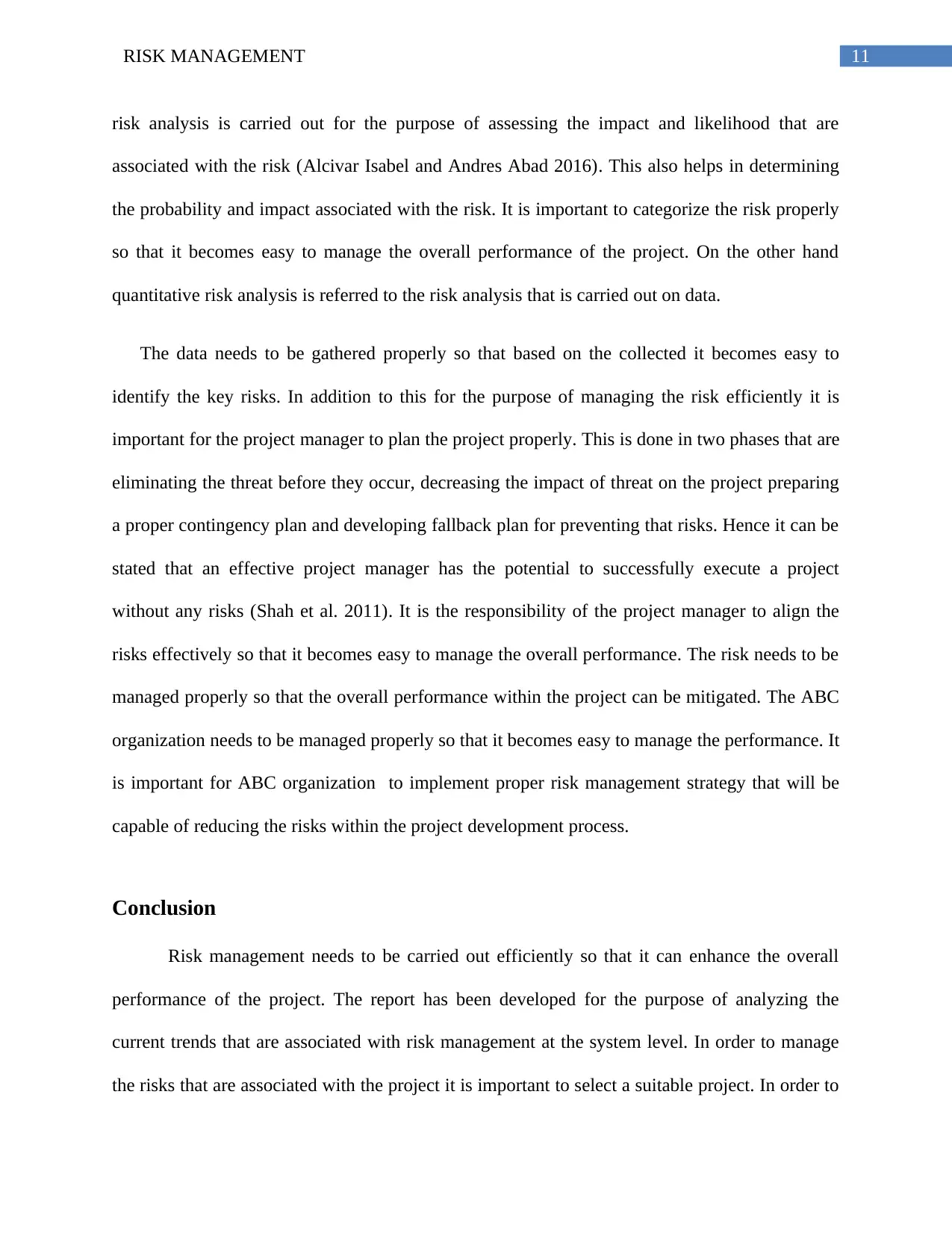
11RISK MANAGEMENT
risk analysis is carried out for the purpose of assessing the impact and likelihood that are
associated with the risk (Alcivar Isabel and Andres Abad 2016). This also helps in determining
the probability and impact associated with the risk. It is important to categorize the risk properly
so that it becomes easy to manage the overall performance of the project. On the other hand
quantitative risk analysis is referred to the risk analysis that is carried out on data.
The data needs to be gathered properly so that based on the collected it becomes easy to
identify the key risks. In addition to this for the purpose of managing the risk efficiently it is
important for the project manager to plan the project properly. This is done in two phases that are
eliminating the threat before they occur, decreasing the impact of threat on the project preparing
a proper contingency plan and developing fallback plan for preventing that risks. Hence it can be
stated that an effective project manager has the potential to successfully execute a project
without any risks (Shah et al. 2011). It is the responsibility of the project manager to align the
risks effectively so that it becomes easy to manage the overall performance. The risk needs to be
managed properly so that the overall performance within the project can be mitigated. The ABC
organization needs to be managed properly so that it becomes easy to manage the performance. It
is important for ABC organization to implement proper risk management strategy that will be
capable of reducing the risks within the project development process.
Conclusion
Risk management needs to be carried out efficiently so that it can enhance the overall
performance of the project. The report has been developed for the purpose of analyzing the
current trends that are associated with risk management at the system level. In order to manage
the risks that are associated with the project it is important to select a suitable project. In order to
risk analysis is carried out for the purpose of assessing the impact and likelihood that are
associated with the risk (Alcivar Isabel and Andres Abad 2016). This also helps in determining
the probability and impact associated with the risk. It is important to categorize the risk properly
so that it becomes easy to manage the overall performance of the project. On the other hand
quantitative risk analysis is referred to the risk analysis that is carried out on data.
The data needs to be gathered properly so that based on the collected it becomes easy to
identify the key risks. In addition to this for the purpose of managing the risk efficiently it is
important for the project manager to plan the project properly. This is done in two phases that are
eliminating the threat before they occur, decreasing the impact of threat on the project preparing
a proper contingency plan and developing fallback plan for preventing that risks. Hence it can be
stated that an effective project manager has the potential to successfully execute a project
without any risks (Shah et al. 2011). It is the responsibility of the project manager to align the
risks effectively so that it becomes easy to manage the overall performance. The risk needs to be
managed properly so that the overall performance within the project can be mitigated. The ABC
organization needs to be managed properly so that it becomes easy to manage the performance. It
is important for ABC organization to implement proper risk management strategy that will be
capable of reducing the risks within the project development process.
Conclusion
Risk management needs to be carried out efficiently so that it can enhance the overall
performance of the project. The report has been developed for the purpose of analyzing the
current trends that are associated with risk management at the system level. In order to manage
the risks that are associated with the project it is important to select a suitable project. In order to
⊘ This is a preview!⊘
Do you want full access?
Subscribe today to unlock all pages.

Trusted by 1+ million students worldwide
1 out of 16
Related Documents
Your All-in-One AI-Powered Toolkit for Academic Success.
+13062052269
info@desklib.com
Available 24*7 on WhatsApp / Email
![[object Object]](/_next/static/media/star-bottom.7253800d.svg)
Unlock your academic potential
Copyright © 2020–2025 A2Z Services. All Rights Reserved. Developed and managed by ZUCOL.





